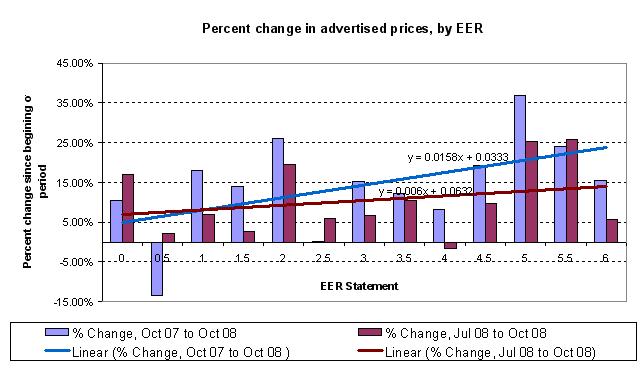
Home Energy Efficiency pays off at sale time
At the end of the last quarter, on average, homes with a 5 star EER were advertised for $160 000 more than homes in lower star bands, and generally, the higher the star value, the higher the advertised price. And, over the past year, the price of the half-star “lemons” has slumped.
The average selling prices for Canberra fell by 2.5% in the last quarter, according to the ABS, However, asking prices have continued to increase, as Energy Partners discovered in their end of quarter analysis of the market. This may reflect unrealistic expectations on the part of the vendors. Overall, buyers have an increased choice in the housing market, and they are choosing energy efficiency, in the form of high EER statements.
Notably, asking prices rose across all star bands in the ACT, between June and September, by 10.5%. This is unexpected, as according the ABS, average sale prices decreased by 2.5% over the same quarter, returning sale prices to September 07 levels. That represents a large discrepancy in what vendors expect the market to do, and what buyers know it has done – up to 13% of a home’s value.
Of the homes on the market at the end of last quarter in Canberra, homes with a 5 star EER were advertised at over $160 000 more than lower star bands, on average. This emphasised the trend of the last year, in which 5 star homes were advertised at $90 000 more than lower star bands. “In general, at the end of the September quarter, the value of a home increased by $5,600 for each EER star,” said Trevor Lee, of Energy Partners.
These new figures are combined with figures collected and analysed by Energy Partners over the 9 years since it was made compulsory that each property sold had an EER included in any advertisement. This shows that the increased price of high-EER homes (3+ stars) is part of a long-term trend of high EERs adding value to homes. That trend was interrupted from 2005 to 2007, coinciding with the housing boom, and a reduction in buyer choice, but now appears to be returning, with a sharp increase in the perceived value of high-EER homes compared to low-EER homes. This is particularly true over the last year, as the average asking price of high-EER homes increased 11% more than that of low-EER homes. Indeed, the average asking price of EER 0.5 homes slumped by nearly 15%!
Cost benefit analysis conducted by Energy Partners has found that investing $2000 in minor renovations, such as adding insulation, good curtains, blinds and pelmets can raise most homes to more than 4 stars. Canberrans wanting further information on how to upgrade the energy rating of their homes can access the ACT Government’s free householder energy advice service at www.heat.net.au or, for a specific question, [email protected]. Energy Strategies and Energy Partners, both of Manuka, offer individualized advice. Visit their website at www.enerstrat.com.au .
Energy Partners is a multi-disciplinary consulting practice, established in 1989. Based in Manuka, ACT, it focuses on the issues of energy and environmental impact within the built environment.
Trevor Lee, B Arch (hons) ARAIA is the Director for Buildings for Energy Partners.
Phone: 02 6260 6173 Email: [email protected]







